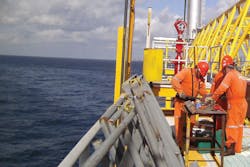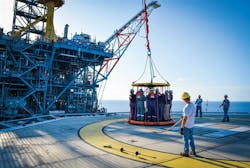With an increase in global demand, volatile prices and stringent environmental regulations, the oil and gas industry must make moves to reduce costs, optimize the performance of its industrial assets and improve its environmental footprint. Among a number of other approaches, implementing a proper preventive maintenance strategy should be the first consideration for oil and gas companies — choosing to be proactive and not reactive in reducing operational risk.
To remain competitive and make a profit in the oil and gas industry, operators must realize the value in protecting company assets. Managing company assets efficiently and effectively has become a critical business reality, and oil and gas operators need to initiate an aggressive asset management program. A successful strategy will both protect and enhance the value of assets, while making sure that due care is taken in their daily use. A proper strategy will also improve maintenance productivity, reliability and asset longevity, while improving the technical and administrative skills of the workforce.
A costly breakdown
Historically, the oil and gas industry has been reluctant to adopt modern technologies and practices for the management of oil and gas sites, a mindset that is often still applied to maintenance strategies. A high percentage of all maintenance time, cost and energy is spent on reactive activities with many companies continuing to fix equipment issues as they occur. Typically, reactive maintenance is 60 to 70 percent less efficient than planned and scheduled maintenance, and it is estimated that an emergency repair job requires three to four times more manpower, time and money than a scheduled repair. Maintenance costs can be hidden, too, such as the cost of shutting down a smaller unit for repair or the cost of deferred production and disrupted schedules.
A complete shutdown can consume a yearly maintenance budget in less than five weeks, with the complexity of the shutdown often increasing over time, becoming even more costly and difficult to manage.
In July 2016, Westlake Chemical Corporation’s Calvert City complex in Kentucky underwent a complete restart procedure as a result of a mechanical failure. The financial consequences of the outage were estimated at $40 million, affecting revenues for more than six months.
Preventive measures
The primary goal of maintenance is to avoid or mitigate the consequences of equipment failure. But focusing on preventing failures before they occur is a relatively new realization for the oil and gas industry.
Condition-based monitoring (CBM) is a maintenance strategy that monitors the condition of an asset to decide what maintenance needs to be done and when. CBM dictates that maintenance should be performed when certain indicators show signs of decreasing performance or upcoming failure. It is designed to preserve and restore equipment reliability by replacing worn components before they cause an issue.
Operators taking a CBM approach through remote asset monitoring can significantly minimize the risk of plant shutdown. Live data feeds offer a real-time overview of operations, enabling passive ongoing monitoring until intervention is required. As soon as a change in condition is identified by the remote monitoring location, it can be analyzed and, if necessary, an engineer can be sent with all of the required equipment and parts to solve the issue.
This new monitoring system will significantly reduce the cost and disruption of meter repairs. The breakdown of a meter could delay environmental reporting — a serious breach of regulation in many regions — and greatly impact production if pipelines need to be shut down for repairs. With CBM, potential issues can be identified and dealt with before they become a high-cost, time-intensive problem.
Other preventive maintenance strategy activities include partial or complete overhauls at specified periods, oil changes, lubrication and minor adjustments. Personnel working on-site can also contribute to improved maintenance strategies by recording any equipment deterioration so they know to replace or repair worn parts.
There is no blanket solution for machine maintenance of various equipment and facilities. For example, maintaining certain equipment may mean adhering to a "preventive maintenance checklist" that includes small checks, which can significantly extend lifespan. Furthermore, other considerations such as weather and equipment need to be taken into account; for example, in the case of HVAC systems, maintenance is often performed before the hottest time of the year.
Maintaining a safe environment
Protecting revenues should not be the only driving force behind regular preventive maintenance procedures. All oil and gas sites should regularly monitor equipment to counteract the inevitable aging of assets. If maintenance is not carried out for a significant period of time, maintenance equipment will degrade and require repair.
Aging oil rigs that have not been properly maintained are now a growing concern for the oil and gas industry. It is estimated that over the next seven years, more than half of the world’s oil rigs will be more than 30 years old. Consider the Gulf of Mexico. In this region alone there is more than 100 operational rigs that were built before 1960. Approximately 50 percent of the Gulf ’s more than 3,000 platforms are considered by federal regulators to be past their intended design lifetime.
Not only does old equipment fall short of operational capabilities compared to its modern counterparts, but it also increases risk for companies working on old rigs. Personnel are regularly exposed to the threat of systematic failures such as pipeline leaks and/or equipment breakdowns. As operators face tighter budgets in light of the 2014 oil crash and are forced to extend the lifespan of already aging rigs, these risks will only mount.
A fatal consequence
In 2010, an explosion on the Deepwater Horizon drilling rig in the Gulf of Mexico killed 11 people and led to one of the biggest oil leaks in history. The blowout and oil spill was reportedly caused by a flawed well plan that did not include enough cement, but a catalog of errors were identified.
The Deepwater rig had an on-board gas detection system that should have sounded an alarm and triggered the closure of ventilation fans to prevent gas reaching potential causes of ignition, such as the rig’s engines. This system failed.
The explosion then destroyed the control lines crew were using to attempt to close safety valves in the blowout preventer. However, the blowout preventer has its own safety mechanism in which two separate systems should have shut the valves automatically when it lost contact with the surface. One system seems to have had a flat battery and the other a defective switch. The blowout preventer could not be closed.
Oil rig explosions may be the worst consequence of poorly maintained equipment — but many safety hazards could be reduced with a proper maintenance strategy in place.
A higher hazard
Dropped objects rank among the top 10 causes of fatalities and serious injury. More than 70 percent of dropped objects in the oil and gas industry are from equipment parts or unsecured objects resulting from aging equipment on older rigs and material degradation.
Material degradation or corrosion is the most common cause, yet is the most difficult to identify. Internal corrosion in mounting structures is particularly hazardous as fixtures must generally support weight at a height, making them more prone to structural failure.
Corrosion on aging fixtures is also difficult to spot on the surface, concealed by layers of heavy paint from a long history of maintenance work. Routine inspections can be effective at identifying problematic areas and — with regard to an oil rig’s old age — regular preventive maintenance should be carried out. Action should be taken to ensure that personnel working on oil rigs — old and new — are protected from such hazards.
Prevent & protect
Asset monitoring and maintenance is needed in every industry to ensure the effective and productive running of operations. However, as a risk-heavy industry, oil and gas companies need to dedicate time and money to maintain equipment and regularly check sites for manufacturing issues or leaks. In hostile, hardto- access areas, the need for asset monitoring intensifies and new regulations have put increased pressure on operators to improve operations and the accuracy of subsequent reporting. Traditionally, asset monitoring was a manual process, with individuals having to test equipment in person and access dangerous environments — at great cost and risk. However, Internet of Things applications such as CBM have introduced a new way to remotely monitor assets at a fraction of the cost and from a much safer distance.
Defining and developing a preventive maintenance strategy is the first line of defense against unplanned plant shutdowns or emergency incidents. Once this has been realized, connected technologies can greatly reduce the risk of accident or injury in oil and gas operations, improve emissions monitoring, and provide insightful data to advance on-site operations.
Martin Phillips is product manager at Fluenta, the global leader in ultrasonic flow measurement for the oil and gas and chemicals industries. Formerly product manager at Nokia and Honeywell, Phillips has worked in marketing and product management for more than 30 years, accruing international expertise in the full life cycle development and launch of products across diverse market sectors.




